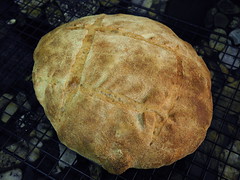 A pugliese, Reinhart says, is a rustic bread similar to ciabatta but baked in rounds instead of slipper shapes, and using durum flour. It should be a very wet dough when baking with U.S. flours, to get the characteristic large open holes. I couldn't find any variety of durum flour (besides the coarser-grained semolina), so for me this bread was another chance to practice handling very wet dough. I'm still doing catch-up blogging: I baked the pugliese July 31.
A pugliese, Reinhart says, is a rustic bread similar to ciabatta but baked in rounds instead of slipper shapes, and using durum flour. It should be a very wet dough when baking with U.S. flours, to get the characteristic large open holes. I couldn't find any variety of durum flour (besides the coarser-grained semolina), so for me this bread was another chance to practice handling very wet dough. I'm still doing catch-up blogging: I baked the pugliese July 31.The pugliese starts with a biga--flour, water, and yeast mixed to a firm dough, let rise, then refrigerated for at least overnight. Come to think of it, so did the potato rosemary bread, and what I did was make a full recipe of biga, then split it to make half recipes of that one and this. I also used leftover mashed potato from the potato-rosemary bread, learning from that loaf to press the potato through a sieve to get out the lumps.
Don't remember much of this one, except that I think I deflated it when trying to slash the loaf despite my new and therefore supposedly sharp lame. I must be lacking in the proper technique. The bread had a nice flavor (we ate most of it dipped in olive oil and herbs), but it was flat and didn't have the larger holes shown in the book. Technique again--if I made high-hydration breads every week for a while, I might get this down.




No comments:
Post a Comment